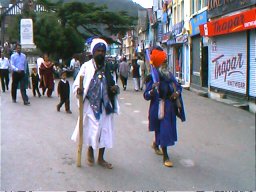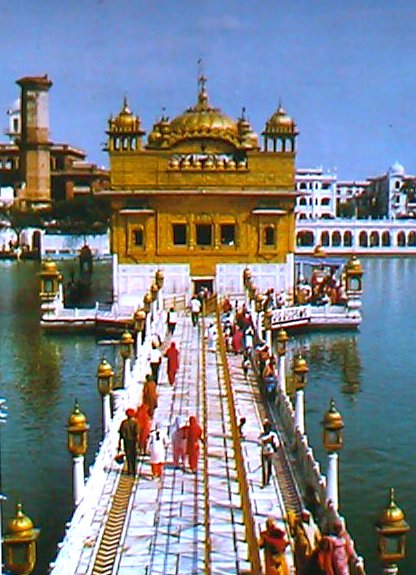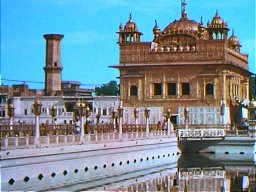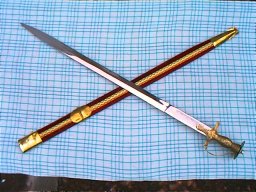|
All images and text are copyright protected. Contact
|
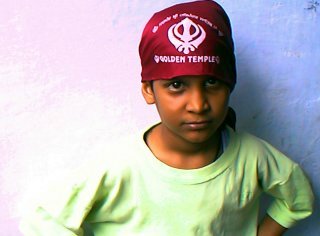 Amritsar Chatting with a Brahmin family in Rajasthan, I ask if the son would be allowed to remain in the home were he to convert to Sikhism. The father shakes his head, "No, we cannot allow that." The son asks, "I am a Brahmin, why would I want to become a Sikh?" The word 'Sikh' comes from the Sanskrit shishya meaning disciple. Sikhism, a mixture of Hinduism and Islam, was founded in the 15th century by Guru Nanak who discarded the many gods and goddesses of Hinduism in favour of the one God of Truth, Sat. He rejected the caste system, idol worship and sex discrimination. He taught that through meditation, charity and bathing, one could break the cycle of rebirth. Later gurus collected the hymns into Holy Books called the Adi Granth and built the Golden Temple in Amritsar, the centre of Sikhism. They also earned the wrath of the Mughal Emperors in Delhi and the scorn of the Hindus for rejecting their gods and, for most Sikhs, war became a way of life. The tenth, and last, Sikh guru, Gobind Singh, founded the Khalsa Brotherhood, where Sikh men vowed to renounce their Hindu names and take the name Singh, not to smoke nor eat meat and to adopt the five kakkars: the wooden comb (kangah), the sword (kirpan), the steel bracelet (kara), the baggy underpants (kachch) and their uncut hair (kesh) which they wore under turbans. The Sikhs also have strong reputations for charitable works and hospitality but sadly, we saw no evidence of either in Amritsar.
Despite their admission that there were vacancies, The Sri Guru Hargobind Niwas' Sikh receptionist insists that we wait at another hotel while the rooms are cleaned. "We'll wait in your lobby," I say. "No, you wait at Sri Guru Ram Das Niwas Gurudwara," he insists. "That's where all the foreigners go." We go to see the Gurudwara which is a kind of flophouse with people sleeping on the floors and return to the Hargobind Niwas. "We have no more rooms," he says with aplomb. "I must say you're not very honest," I comment. "Are all Sikhs dishonest like you?" He chooses not to hear me but perhaps it is a simple matter of baksheesh.
In the early 1980's, the militant Sikh organisation, Shiromani Akali Dal, demanded a breakaway from India and the founding of a new Sikh nation, Khalistan, which resulted in several skirmishes with Hindus in Punjab. Indira Gandhi sent the army to besiege the Golden Temple which turned into a 4-day battle and, in an act of vengeance, was assassinated by her Sikh bodyguards. Despite being so far north, Amritsar is still hot in May. I sit in the shade while Sanjay chats with sword carrying Sikhs in blue tunics. Punjabis have their own spoken and written language. "What language did you use with him?" I ask Sanjay who speaks Hindi, Rajasthani and English. "I can understand a little Punjabi. Some words, I cannot understand. Do you want to talk with him?" I shake my head. I like people with passionate natures but I dislike fanatics. We walk through the Central Sikh Museum housed within the complex. There are paintings of Sikh heroes fighting the Mughals, being executed, being tortured, dying with honour, painful bloody photographs of Sikh heroes who died gloriously in the 4-day battle of the Golden Temple in 1984. Sikh visitors walking by look bored. Not far from the Temple is Jallianwallah Bagh, a narrow lane leading to an enclosed park that was the site of a horrific massacre on 13th April, 1919. On that day, about 10,000 Indians had gathered to peacefully protest a law that allowed the British to imprison Indians without trial. British Brigadier-General Reginald Dyer ordered his 150 soldiers of the British Indian Army to block the only exit and open fire upon the men, women and children without warning, killing 400 and wounding 1500 others.
A number of Indians subsequently journeyed to England to assassinate British nobles and high-ranking military men in revenge. At their trials (fortunately, they were given trials), they proudly admitted their guilt and mourned that they had no opportunity to slay more Brits to even the score. They were hanged but Brigadier-General Reginald Dyer was never charged for his crime. The killing of one white Brit was a crime punishable by death, but, typical of British way of thinking, the slaying of 400 Indians was not considered a crime. The Bengali poet, Rabindranath Tagore, returned his knighthood which made little impression on anyone. In 1997, Queen Elizabeth II visited the site but made no apology for the heinous crime apart from calling it regrettable, like missing a dinner engagement. Today, in the museum, there are exhibits of moving eyewitness accounts of the tragedy by surviving men and women. The buildings within the area still bear the actual bullet holes in the walls, a memorial to British justice. And the well where dozens of Indians drowned attempting to escape the slaughter has been preserved for posterity. The younger Indian visitors picnic on the grass obliviously, but the older ones gently, silently, touch their fingers to the bullet holes. India commemorates the event every 13th April as Jallianwallah Bagh Massacre Day. Missing fruit in my diet, I buy a few mangoes that are pricey since the season is still young. At an American-looking pizza parlour, the pizzas are tasty enough but hardly generous in the ingredients. A vegetarian restaurant serves better food (aloo parathas, channa, lassi) at reasonable prices and the service is very good. It is the only pleasant memory of Amritsar that I take with me.
"When should I come back?" I ask, still not getting it. "Tomorrow," they reply, probably wondering how long it would take me to get it. I phone my Delhi friend who asks, "You want to go where? They're fighting in Srinagar again. You'll get killed. Haven't you been reading the papers?" "We haven't seen a newspaper in weeks. Are they killing tourists?" "Tourists especially. Besides, they're mostly using bombs and bombs don't choose. Why don't you go to Manali or Dalhousie? They're also interesting and much safer." In the morning we leave the hotel and go to the bus station. There is a government bus going to Dharamsala at 8 o'clock. It is painted green with colourful flowers and a little worn. Sanjay has qualms but gives in gracefully as it is the quickest way out of Amritsar. Half the passengers are Sikhs with turbans in khaki, blue, red, yellow, black and pink. We go through hot, dusty towns and there is a half-hour wait in Patankot where we are ripped off by the kachourie vendor. The bus station workers are all too busy to answer our questions; they merely point to the bus and return to their work. For many Indians life is suffering, a thing to be endured: make money, make children, make peace with god and make pilgrimage to avoid being reincarnated. For many, death is a welcome event, leading to a better hereafter or, at least, a respite until the next rebirth.
Raceandhistory.com | Howcomyoucom.com | Trinicenter.com | TriniView.com Another 100% non-profit Website serving poorly represented communities. Copyright & Disclaimer. - - Privacy Policy --Designed & maintained by S.E.L.F. © 2002 TriniView.com |

